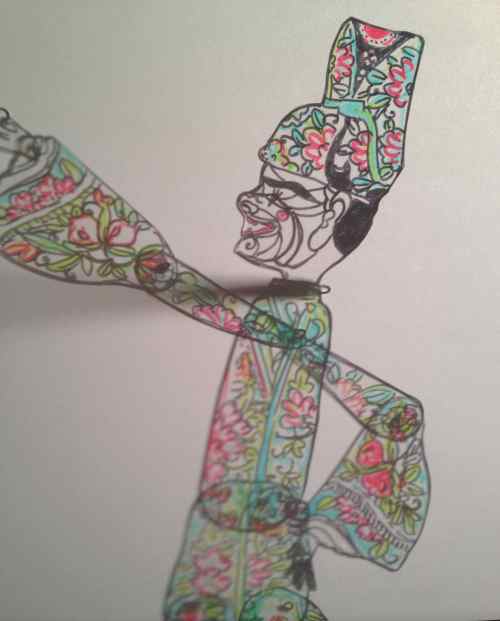As I’ve continued to delve into the world of Chinese shadow puppetry, it’s become clearer and clearer to me that the form’s continued obscurity is one of its main obstacles to survival. In North America, when I begin to tell someone what I do, and they’re kind enough not to glaze over in the eyes, I usually get one of a few standard responses: 1) You mean like the Muppets? 2) Like Being John Malkovich? 3) Or, they put up their hands in a complicated tangle of fingers and say ‘like this?’ In China, the problem isn’t that much better. Everyone has heard of shadow puppetry, but very few have ever seen a live performance.
For numerous reasons, China wasn’t a large exporter of their cultural forms throughout the middle part of the 1900s. Even now, though China has ostensibly become increasingly open, the focus remains on economics, the environment and politics, which leaves little room to push the arts as ambassadors. Even if they had, most of their folk arts forms haven’t warranted enough attention to be exported, even when that has been the trend. There has been the odd article here, the occasional post or book there, but for the most part Chinese shadow puppetry still remains out of the general consciousness.
This lack of attention has seemed to stutter my research at times, making me divert my attention away from the work simply to publicize. But, over the years, this has actually helped hone the work, my goals and continues to reinvigorate what the true mission of my research should always be: sharing and engaging. Just when I think I’m tired of hitting the book, writing papers, conducting fieldwork – I am gifted a moment of true sharing and it does wonders to propel me forward.
Just this past spring, I’ve had the great honor to present a lecture/workshop at the Atlanta Center for Puppetry Arts (aka puppet-wonderland) and a demo/workshop at the incredible Virginia Museum of Fine Arts. Both experiences, while acting as platforms for me to share Chinese shadow puppetry, were also vehicles towards sharpening my own understanding of how to share the work and what about it is relevant to a diverse North American public.
In Atlanta, the workshop participants were largely made of up adult educators and puppet professionals. The center’s educational outreach has also mastered the webinar format – allowing participants from as far away as Hawaii and Australia to participate as long as they have an internet connection! This was a first for me.
 The webinar audience is supported by a team of folks who video and moderate questions and information. It’s fabulous if you’re stuck in the boondocks but want to join in puppet workshops.
The webinar audience is supported by a team of folks who video and moderate questions and information. It’s fabulous if you’re stuck in the boondocks but want to join in puppet workshops.
They all delighted me with deeply considered questions about the history, but more interestingly, they wanted to know about the making process: how was the leather handled, what types of blades are used to cut the hide, what pigment options are out there, what are the joints and rods made out of, etc. This engineering minutia is the aspect of my work that I have shared the least. Hearing their curiosity confirmed that I’m not alone in my interests here.
In Virginia, the museum’s incredible art education and events staff and I developed a new set-up for large groups of festival goers to partake in both/either shadow puppetry or a make-your-own shadow puppet project. With a family audience of around three thousand people in a matter of a few short hours, we knew we had to make both activities easily accessible and feasible, but also engaging and interactive. Most successful were the new simplified child-proof Chinese-style shadow puppets I created that are sturdy enough for the rowdiest of kid rebels, yet beautiful enough to warrant enchantment. (A Do-It-Yourself Post will follow in a few weeks.)
 A plastic, child-proof Chinese shadow male clown figure, ready for play.
A plastic, child-proof Chinese shadow male clown figure, ready for play.
I’ve toyed with plastic before and never loved the results, but these satisfied me. And, most importantly, the kids (and adults) fell in love with them.
 Parents often ‘help’ their kids get acquainted behind the screen, but really end up enjoying it just as much as their half-pints.
Parents often ‘help’ their kids get acquainted behind the screen, but really end up enjoying it just as much as their half-pints.
 I love the natural curiosity to see what’s going on on both sides of the screen, even when you’re the one doing the puppeting.
I love the natural curiosity to see what’s going on on both sides of the screen, even when you’re the one doing the puppeting.
We had kids who were there so long, I had to request they make room for others only to find them back again after a short pause. At moments in the chaos, I’d look around the mob of children at the screen or studiously making their shadow puppet and felt profoundly encouraged. There was a reason Chinese shadow puppetry survived and thrived for so long, and there is a reason it should continue – it’s just taking a little time to catch up to this crazy modern world. Proof is in the puppet.
Thanks for reading~














































